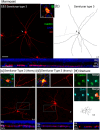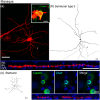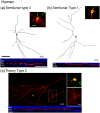Spatial Distribution and Morphology of CaMKII-Expressing Amacrine Cells in Marmoset, Macaque, and Human Retina
- PMID: 40705462
- PMCID: PMC12288868
- DOI: 10.1002/cne.70078
Spatial Distribution and Morphology of CaMKII-Expressing Amacrine Cells in Marmoset, Macaque, and Human Retina
Abstract
Over 30 types of amacrine cells have been described in the primate retina, yet few are well characterized. Here, we investigated amacrine cells expressing the alpha subunit of calcium/calmodulin-dependent protein kinase II (CaMKII) in the retinas of human, macaque (Macaca fascicularis, Macaca nemestrina), and marmoset (Callithrix jacchus) monkeys using immunohistochemistry and intracellular injections, with a focus on displaced amacrine cells (dACs) in the ganglion cell layer. The spatial density of CaMKII-positive dACs decreases with the distance from the fovea, but in the peripheral temporal retina, the density of CaMKII-positive dACs nevertheless exceeds the density of retinal ganglion cells. In all species, CaMKII-positive dACs include cells expressing choline acetyltransferase (ChAT) cells, but in the human retina, only 60% of the ON ChAT population is CaMKII-positive. Conversely, in the marmoset and the macaque, about 80% of ON ChAT cells co-express CaMKII, but only 55% of ON ChAT cells in humans do so. Intracellular injections of CaMKII-positive dACs with the lipophilic dye DiI revealed ON starburst and semilunar Type 3 cells in all three species, but in the human retina, at least three additional types were detected. In the inner nuclear layer, CaMKII is expressed by multiple populations of amacrine cells, which are distinguished based on their soma size and staining intensity, but OFF ChAT cells do not co-express CaMKII. We conclude that ON- and OFF-ChAT cells show distinct patterns of CaMKII expression and that the diversity of CaMKII-expressing dACs in humans is greater than that in marmoset or macaque retina.
Keywords: CaMKII; amacrine cells; human; macaque; marmoset; primate retina; vision.
© 2025 The Author(s). The Journal of Comparative Neurology published by Wiley Periodicals LLC.
Conflict of interest statement
Dr. Grünert is an editorial board member of
Figures


















Similar articles
-
Comparative Analysis of Tyrosine Hydroxylase Amacrine Cells in the Mammalian Retina: Distribution and Quantification in Mouse, Rat, Ground Squirrel and Macaque Retinas.Int J Mol Sci. 2025 Jul 20;26(14):6972. doi: 10.3390/ijms26146972. Int J Mol Sci. 2025. PMID: 40725219 Free PMC article.
-
Melanopsin and calbindin immunoreactivity in the inner retina of humans and marmosets.Vis Neurosci. 2019 Jun 18;36:E009. doi: 10.1017/S0952523819000087. Vis Neurosci. 2019. PMID: 31581958
-
Retinal ganglion cells expressing CaM kinase II in human and nonhuman primates.J Comp Neurol. 2022 Jun;530(9):1470-1493. doi: 10.1002/cne.25292. Epub 2022 Jan 14. J Comp Neurol. 2022. PMID: 35029299 Free PMC article.
-
A rapid and systematic review of the clinical effectiveness and cost-effectiveness of paclitaxel, docetaxel, gemcitabine and vinorelbine in non-small-cell lung cancer.Health Technol Assess. 2001;5(32):1-195. doi: 10.3310/hta5320. Health Technol Assess. 2001. PMID: 12065068
-
Evolution of rod bipolar cells and rod vision.J Physiol. 2025 Jan 7. doi: 10.1113/JP287652. Online ahead of print. J Physiol. 2025. PMID: 39775947 Review.
References
-
- Boycott, B. B. , and Dowling J. E.. 1969. “Organization of the Primate Retina: Light Microscopy.” Philosophical Transactions of the Royal Society of London Series B‐Biological Sciences 255: 109–176. - PubMed
-
- Buccitelli, C. , and Selbach M.. 2020. “mRNAs, Proteins and the Emerging Principles of Gene Expression Control.” Nature Reviews Genetics 21: 630–644. - PubMed
-
- Busskamp, V. , Picaud S., Sahel J. A., and Roska B.. 2012. “Optogenetic Therapy for Retinitis Pigmentosa.” Gene Therapy 19: 169–175. - PubMed
MeSH terms
Substances
Grants and funding
LinkOut - more resources
Full Text Sources
Miscellaneous

